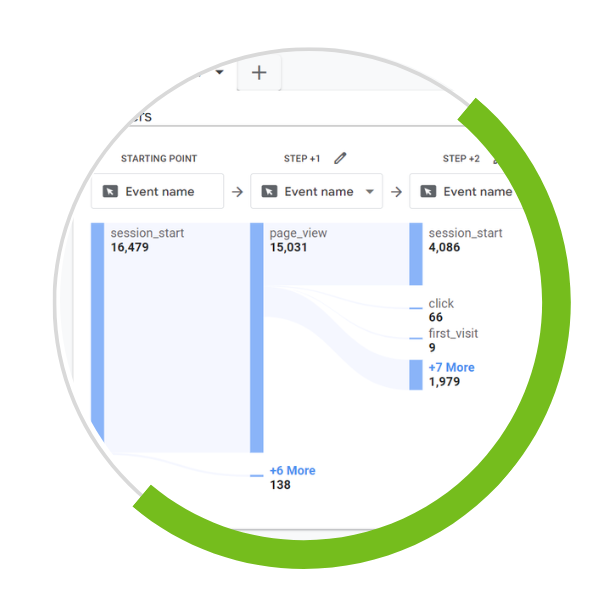Search engine optimization (SEO) is the process of optimising a website to improve its visibility and ranking in search engine results pages (SERPs). When someone searches for a particular keyword or phrase on Google or other search engines, the search engines use an algorithm to determine which websites should appear in the top organic search results based on various factors.
This guide to SEO Basics has been written based on the combined SEO knowledge of our team of content marketing and SEO experts. It will cover the SEO basics that will help you understand each ranking factor and boost search traffic on your own site for target keywords.
The goal of search engine optimization is to make your website more visible and relevant to search engines by optimising its content, structure, and other elements that search engines use to evaluate websites. These can include the meta description on important pages or the URL structure, among other factors. By improving the visibility and ranking of your existing site in Google search results, you can attract more organic traffic to your website, which can result in more conversions, leads and sales.

SEO can be divided into two main categories: on-page SEO and off-page SEO. On-page SEO refers to optimising the content, structure, and technical elements of your website to improve its relevance to Google and other search engines. This includes optimising each web page’s title tags, meta description, content, headings, internal links and URL to make them search engine friendly. Off-page SEO, on the other hand, refers to the SEO strategy that takes place outside of your website to improve its authority and reputation. This includes building high-quality backlinks to each important web page, social media promotion, and influencer marketing.
SEO is a long-term strategy that requires ongoing effort and investment to see results. Search engines work by comparing various web pages and deciding which ones best meet the needs and intent of the searcher, then displaying those pages in priority order. So to succeed with SEO requires understanding not only your own website and content but also your competitors’ website and content. This is why Competitor Analysis is such an important aspect of an SEO strategy. SEO basics are only the start of the process but with time and commitment, the benefits of SEO can be significant. It will help you reach a larger audience, increase brand visibility and credibility, and ultimately drive more business revenue.
What are the most important ranking factors for SEO?
The most important ranking factors for SEO (Search Engine Optimisation) can vary depending on the search engine algorithms and their updates, but generally, the following factors are considered to be essential:
Content
- High-quality, relevant, and original content that satisfies the user’s search intent is critical. Search engines aim to provide the best possible results to their users, and content that matches their intent in a search result is essential. Content on web pages can take the form of a blog post, in-depth article, case study etc. When you create content for your site’s pages use a “customer-first” approach and write for human readers but also consider a target keyword (or long tail keywords).
Keywords or Search Phrases
- Including relevant keywords in the content, title tags, meta description, and other on-page elements can improve visibility in search results for your site’s pages. However, stuffing keywords or using irrelevant keywords can harm your keyword rankings. Use a keyword research tool to help determine the most valuable keywords for your business based on search volume and local SEO considerations to achieve SEO success. If you have a Google Ads account you can use their Keyword Planner which is one of several free keyword tools.
Backlinks
- The quality and quantity of external websites linking to your website can indicate your website’s authority and credibility. Building quality backlinks from authoritative websites are a ranking factor and can improve your ranking and boost search traffic to your site’s content. Building links is a vital part of any SEO campaign.
User Experience
- Search engines aim to deliver a positive user experience (UX) to their users. A website’s loading speed (page speed) and whether it’s mobile friendly can impact the user experience and ultimately affect if it will be one of the top ranking pages. Google’s Core Web Vitals metrics are an important part of measuring page speed performance and can be viewed in Google Search Console for both desktop users and mobile users. Meta descriptions are also important for UX as they give an indication of what a person will find if they click on a particular search listing. Make sure every meta description is accurate so visitors find what they expect.
Technical SEO
- Technical SEO includes optimising the website’s URL structure, internal links, crawlability, and other technical aspects to improve search engine visibility and user experience for desktop and mobile users. Google Search Console is a great free tool for checking many technical attributes when you are aiming to cover the SEO basics. However, once you advance beyond SEO basics we recommend using more advanced SEO Audit tools that can highlight other issues and provide recommendations not available from Google Search Console.
Domain Authority
- Domain authority is a measure of a website’s overall credibility and relevance based on various search engine optimization factors such as age, backlinks, and content quality. A higher domain authority can improve ranking. Domain Authority (DA) is an industry-standard metric from Moz but there are similar metrics available such as Domain Rating (DR) from Ahrefs and Trust Flow (TF) from Majestic SEO.
Remember that SEO is a long-term strategy, and it requires continuous efforts to maintain and improve your ranking.
LEARN MORE ABOUT OUR
Website Audit Services
Let’s look in more details at each of these 7 important SEO ranking factors…
What is the best type of content to produce for SEO purposes that also meets the needs of human readers?
Some of the best content types that can satisfy both search engines and human readers include:
Blog posts
- Blog posts that offer comprehensive information on a particular topic or answer specific questions related to your business can attract organic traffic and satisfy the user’s search intent. Whilst a Keyword Research tool can help identify important topics for your blog posts and provide insights into the search volume each month in your target country, there are other useful ways to determine relevant topics. This approach perhaps goes beyond SEO basics but it’s useful to be aware that people search for terms with lower search volume that will not be identified by a standard keyword tool, but can still drive highly targeted and relevant traffic to your website. For that reason always monitor your Google Analytics data in case a particular blog post is driving a lot of traffic to your site’s pages. This can identify content that is worth expanding and improving with calls-to-action (CTAs) to better engage those readers via internal linking to other related content.
Infographics
- Infographics can effectively communicate complex data or information in a visually appealing and easy-to-understand format. They can also attract backlinks from other sites, which can improve your website’s authority and ranking position in Google search.
Videos
- Videos are an excellent way to engage with your audience and convey information in an entertaining and informative way. They can also improve your website’s dwell time and increase engagement rate (which is equivalent to reducing bounce rate), which can signal to search engines that your content is valuable and relevant.
How-to guides
- How-to guides that offer step-by-step instructions on how to do something or solve a particular problem can satisfy the user’s search intent and provide value to the reader. They can also attract organic traffic and backlinks. For these reasons search engines value this type of content in a search engine marketing and SEO strategy. Whatever guides you decide to create ensure you have completed thorough keyword research and regularly monitor your Google Analytics to make sure the guides meet people’s needs.
Case studies
- Case studies that showcase your business’s success stories or demonstrate how your product or service helped solve a problem for your customers can build trust and credibility with your audience. They can also provide valuable insights and information to other businesses or individuals looking to achieve similar results. This all contributes to SEO success because people read and engage with your content marketing efforts. Don’t forget the importance of visually appealing CTAs to keep your readers on your website.
It’s essential to keep in mind that producing quality content that meets the needs of both search engines and human readers is a continuous effort that requires careful planning, ongoing keyword research and ongoing search engine optimization (SEO). Search engines work by continuously improving what they offer and your own site and content needs to do the same to achieve and maintain good organic search results.
Are keywords still important to succeed with Search Engine Optimization?
Keywords are still important to succeed with Search Engine Optimization (SEO) by generating organic traffic relevant to your business. But their importance and usage have evolved over the years. Traditional Keyword Research still has an important part to play in a digital marketing strategy but other methods of researching what your customers are looking for are also vital to success. Keyword stuffing and targeting exact match keywords is no longer effective and can even harm your Google search ranking. However, using relevant and targeted keywords in your content and meta data (such as Page Title, Meta Description and image Alt Text) can still help search engines understand the content of your website and improve its visibility in organic search results.
Here are some ways in which keywords are still important for SEO:
- Understanding User Intent: Keywords can help you understand the intent behind the user’s search queries, which can help you create relevant and valuable content that satisfies their needs.
- On-page SEO: Including relevant and targeted keywords in your title tags, meta description, headings, and content can signal to search engines what your content is about and improve its chances of appearing in relevant search results.
- Content Creation: Creating high-quality and engaging content that includes both targeted keywords and “Natural Language” words and phrases can help you attract organic traffic and improve your website’s authority and relevance.
- Competitor Analysis: Analysing your competitors’ keywords can help you identify gaps in your own content strategy and identify new opportunities to improve your ranking and drive traffic to your website.
However, it’s important to avoid keyword stuffing or targeting irrelevant or low-quality keywords, as this can harm your ranking and even result in penalties from search engines. Instead, focus on creating high-quality, relevant, and engaging content that meets the needs of your audience and satisfies their search intent.
LEARN MORE
Keyword Research & Analysis
What part do backlinks play in SEO and what are the best ways to secure good quality backlinks?
Backlinks play a significant part in SEO as they indicate to search engines that other businesses consider your content to be relevant, trustworthy, and valuable. When a website links to pages on your site, it’s seen as a vote of confidence in your content, and search engines will typically reward your website with higher rankings in the top search result page.
Here are some of the ways that backlinks can impact SEO:
1. Improved Authority
Backlinks from high-quality and authoritative websites can improve your website’s authority and credibility, which can lead to higher search rankings.
2. Increased Visibility
Backlinks can help search engines discover your website and improve its visibility in Google search results. Remember to check Google Search Console for the links that it has detected.
3. Referral Traffic
Backlinks can also drive referral traffic to your website, which can help increase engagement and conversions. Referral traffic can be checked and monitored in Google Analytics.

To secure good quality backlinks, here are some of the best practices to follow:
1. Create High-Quality Content
Creating high-quality and valuable content that satisfies the user’s search intent is one of the most effective ways to attract backlinks from other sites, which, in turn, lead to better search result performance.
2. Outreach to Relevant Websites
Reach out to relevant websites in your industry and offer to guest post or collaborate on content. This can help you secure backlinks from authoritative websites related to your business. Obviously avoid contacting direct competitors!
3. Monitor Your Competitors
Keep an eye on your competitors’ backlink profile with one of the industry standard tools such as Ahrefs, Majestic SEO, SEO PowerSuite or SEMRush. Identify opportunities to improve your own backlinks by using these backlink analysis tools to identify websites linking to your competitors and reach out to them. Bear in mind that analysing only competitors’ backlinks will only help you keep pace with them but not outperform them. Additional research will be required to identify other sites that could potentially link to your website. This can sometime stake the form of analysing websites in different sectors entirely, especially if they are complementary industries.
4. Build Real Relationships
Building real relationships with other websites and influencers in your industry can help you secure backlinks and drive referral traffic to your website.
Remember that the quality of the backlinks is more important than the quantity. Aim for relevant, high-quality, and authoritative websites linking to your website, as this will have a more significant impact on your SEO than a large number of low-quality backlinks.
More advanced stuff about backlinks & link-building
- What is a backlink?
- Types of backlinks
- Understanding backlink profiles
- Anchor text
- Proactive link building

A backlink is simply a link from one page on one website to another page on another website. The link is referred to as a backlink from the perspective of the destination website.
You might also hear the term “external link”, which refers to the same link from the perspective of the source website.
Note that the term “internal link” refers to a link from one page on a website to another page on the same website. Note that internal links are also an important factor in SEO but in this section we are focusing just on backlinks – so link to your website
Backlinks are one of the most important aspects of SEO for improving organic search rankings.
However, not just any backlink will contribute to improving rankings or, in SEO parlance, “add SEO value”. Some SEO professionals use the term “link equity” or “link juice” but personally I don’t think the latter is very meaningful, even though it is commonly used in SEO circles, and “link equity” is only marginally better.
Why are backlinks important?
Backlinks have always been an important ranking factor within search engine algorithms because they basically give a vote of confidence to a website as a whole and to an individual web page. However, how search engines like Google determine the value of a backlink has changed radically as search algorithms have become better and better at distinguishing high-quality links that are hard to acquire and need exceptional content worth linking to, and poor-quality links from websites that will indiscriminately link out to any sort of content or websites.
Quite simply if multiple good quality websites link to a certain page, then that page is deemed to be both valuable and trustworthy so is more likely to appear higher in the search listings. Always assuming other aspects of SEO are well-optimised.

Nofollow links
A nofollow link is a link that contains the attribute rel=”nofollow” within the HTML code of the web page the link is on. It is used to indicate to Google not to add any SEO value to the page it is linking to. It’s a way for website owners to tell search engines that they specifically are not endorsing another website or giving it a vote of confidence. This is usually where people other than the website owner can add a link – a typical example is when links can be added in comments on blog posts.
Nofollow links don’t directly help with improving rankings but they do have some benefits:
- They drive referral traffic to a website
- They create a more natural backlink profile
- They provide additional information to enable Google to understand a website in terms of credibility and trust.
Sponsored links
A sponsored link is a link that contains the attribute rel=”sponsored” within the HTML code of the web page the link is on. It is used to indicate to Google that the backlink is present due to some financial incentive. This could be because a business has paid to advertise on the linking domain, or paid to publish content containing a backlink.
UGC links
UGC links refer to user-generated content and contain the attribute rel=”ugc” within the HTML code of the web page. It is used to indicate to Google that the backlink is present on a website that allows users to freely add their own content and links. A typical example is for links from forum posts.
Dofollow links
“dofollow” links are links which contain none of the above attributes in the “rel” tag. The term is commonly used to indicate that the link is neither “nofollow”, “sponsored” nor “ugc” and assumed to mean that the website linking out does endorse the website it is linking to.
Although dofollow links tend to be the most sought-after for SEO purposes, it is important to understand that any website with a large percentage of Dofollow links could be seen as unnatural to a search engine algorithm and result in having the opposite effect of boosting rankings.

A backlink profile is the combined attributes and quality of all the backlinks to a website. This overall measure of link quality is just as important as the individual backlinks.
Firstly the quality of backlinks directly impacts rankings, but a certain quantity of backlinks is also necessary, as is a sustained “link velocity” i.e. how many links are built over a regular period of time on an ongoing basis.
Here are some of the parameters that contribute to the quality of individual backlinks:
- Authority of linking domains (using industry-standard metrics such as Domain Authority – DA, Domain Rating – DR, Trust Flow – TF)
- Estimated traffic to linking domains
- Relevancy and uniqueness of content surrounding the backlinks
- Position of backlink on the page (higher up is better)
- Number and quality of other backlinks on the page
And here are some of the parameters that contribute to the quality of all of the backlinks to a website as a whole – known as the Backlink Profile:
- Proportion of “dofollow” links
- Relative proportions of branded and keyword-rich anchor text
- Variety of different anchor texts
- Ratio of linking domains to total number of links

The anchor text of a backlink is the visible, clickable part. This can be text within a paragraph, often highlighted in a different colour and underlined, or it can be text on a call-to-action button such as “Find out more…” or it can be a clickable image. It is important because it helps human reader understand what to expect if they click the link; and it helps search engines determine if the source content is related to the link.
Some of the most common types of anchor text created as part of an SEO strategy are:
- Brand name
- Exact keyword match
- Partial keyword match
- General words
- URL
The aim of an SEO strategy is to develop a natural mix of different anchor texts, although that should include some exact and partial match keywords. It is difficult to define exact percentages for the different types of anchor text (although some tools claim to know the ideal percentages). The best approach is to review what the top ranking competitors in your industry are doing and try and emulate that.

In an ideal world every business would be endorsed by other reputable businesses… but, wait, how would you know which business was best if all businesses were endorsed? It’s a bit like that scene from The Incredibles (one of my Top 10 films of all time). If you know what I mean, you know what I mean.
What that actually means is that to improve the rankings of any website you have to do proactive link-building because, whilst you would hope you acquire some natural links, it is unlikely to be enough to move the ranking-position dial in your favour.
So link building is a major factor in an SEO campaign but it has to be done in a way that is natural because Google is on the lookout for any attempts to gain an unfair advantage.
So it’s perfectly reasonable to create a great piece of content or an interesting infographic for your website then reach out to people to link to the content. It’s also fine to write a blog post, article, press release or case study and reach out to relevant businesses asking if they would like to publish on their website with a link back to your website (of course!). This is a long process not dissimilar to digital PR but worth all the time and effort to secure genuine high-quality links.
When doing outreach to secure backlinks always view the proposition from the content publisher’s perspective. Put yourself in their shoes and ask yourself “what’s in it for me?”. If there’s very little then they are unlikely to be willing to publish your content.
Paying for links – the elephant in the room
You will quickly discover when doing outreach to find websites willing to publish your guest post, case study, press release etc. that there is a whole sub-industry of “link-sellers”. These are websites designed simply to make money from charging to publish your guest post containing a link. These sites appear to have reasonable metrics such as Domain Authority or Domain Rating. They may even appear to have decent traffic – don’t be fooled.
However, if a well-known website is willing to publish for an admin fee then it might be worth considering. Google itself recognises that there are sometimes legitimate financial transactions that result in a backlink.
More advanced link-building strategies
There are a number of different link building strategies that you can try to gain valuable backlinks for a website. Some are quicker and easier than others but it is almost invariably the case that backlinks that are harder to secure will add the most value to your search engine optimization efforts. Search engines are sophisticated enough to know this a reward a website accordingly.
A good approach, then, is to have 2 streams of backlink-building running in parallel: the long-term, more valuable targets and the short-term, easy to acquire, but less valuable ones.
Here are some of the most common strategies that work…
- Create unique linkable assets
- Guest posting
- Analyse competitors’ backlinks
- Use the Skyscraper Technique
- Other link building techniques

Creating unique and informative content on your website aimed at your target audience will build credibility and trust for your brand. When high-quality content is created regularly it also contributes to better rankings in organic search so already that’s 2 good reasons to create great content on your website.
But there’s a bonus too.
This content can become a “linkable asset” i.e. other websites will like it enough to link to it. You will almost certainly need to do some outreach or social media posting to let people know the content exists before it will generate links in any significant number. Sometimes just asking for feedback on social media can generate links.
Here are some good examples of content types that are popular as linkable assets:
- In-depth guides on a relevant topic
- Top xx expert tips
- Collate multiple related statistics from diverse sources into one convenient article
- Research with unique data
- Infographics
- Case Studies
The next step is to find websites that might want to link to you and contact them (more on that in a while).
Pro Tip: Internally link from linkable assets to SEO target pages
Any backlinks that you acquire via this almost natural strategy can generate even more value if you create internal links from your linkable assets to your main SEO target pages.

Guest posting (or guest blogging) is probably one of the most popular link building techniques currently being used. The premise is quite simple but, as previously mentioned, be on the lookout for websites that are not genuine blogs, businesses or organisations and seem to have been set up simply to make money from publishing guest posts. Links from these sites will likely add no value to your backlink profile.
However, there are websites and digital publishing platforms that are genuine so once you have found one here’s the basic principle of guest posting:
- Check if the target publishing website has any requirements or guidelines for guest posts, such as word count or particular topics.
- Write a unique guest post about a relevant topic.
- Ensure the post contains a link to your own web.
The benefit to the publishing platform is a free piece of unique content and your website acquires a free backlink. Just remember what we said earlier about SEO value.

Analysing the backlink profiles of your competitors is also a good source of potential link building opportunities. There are multiple SEO tools that will allow you to do this. They will show the URL of each competitor’s backlinks plus other metrics that will enable you to determine which potential linking website is worth contacting. Again focus on what makes a backlink valuable and look for linking domains that match.
This technique is starting to move away from basic SEO and is more likely to be a process used by an SEO agency or SEO consultant but it’s worth mentioning briefly here.

The Skyscraper Technique (originally coined by Brian Dean from Backlinko) is another simple premise that is less simple to implement successfully. It involves reviewing the top rankings pages for a particular search term and then producing something bigger and better-optimised. Our AI-powered content audit can help ensure your new content is good enough to outperform the competitors in organic search but also contact all of the websites linking to the top competitors’ equivalent piece of content and suggesting they update their links to your content. Be warned that this approach has a low success rate but it’s worth doing because the content itself can rank well and so drive traffic and grow brand awareness.

Supply expert insights to writers/publishers
It is possible to get featured in articles that require expert insights or opinions and obtain a valuable link. The best way to find writers/publishers looking for expert insights is to register with sites like Help-A-Reporter-Out (HARO) and set up notifications of requests relevant to your area of expertise.
Social backlinks
Backlinks from social media sites will always be “nofollow” links so won’t directly add SEO value. However, they can drive traffic to your website and potentially result in natural “Dofollow” links which will add SEO value.
Forums and Q&A sites
Backlinks from forums and Q&A sites like Quora, Medium or Reddit will usually be “nofollow” but like social media links can drive traffic to your website. Occasionally if a post on Medium generates a lot of interest then it might be switched to a “Dofollow” link.
Link building techniques not recommended
There are some other link building techniques often mentioned in SEO guides but, in our experience, they are not worth the time invested in them because of the extremely low success rate. So the following techniques are not recommended:
Broken link building
This requires finding websites with broken links (i.e. the URL contained in the link no longer exists and has not been redirected). There are SEO tools that can help identify these broken links. Then you contact the website to inform them of the broken links and suggest your content as a replacement.
Unlinked brand mentions
This requires finding unlinked mentions of your brand and asking the ask the website owners to add a link the mention of your brand name. Again there are various tools to help you identify the unlinked mentions.
What are the factors that will help websites to deliver a positive user experience to their users?

Here are some of the SEO basics that can help websites deliver a positive user experience to their users, whilst also keeping search engines happy. Delivering a good UX in Google’s search results is essential to the success of any website so no guide to SEO would be complete without mention of the following:
Navigation
A clear and intuitive navigation menu that makes it easy for users to find what they are looking for is essential to a positive user experience.
Page Load Time
Fast page load times are critical to a positive user experience, as users are more likely to abandon a website that has a poor page speed and takes too long to load.
Mobile Responsiveness
With the ever-increasing use of mobile devices, having a website that is mobile-responsive is essential to delivering a positive user experience. A mobile friendly website adapts to the user’s device and provides an optimal viewing experience. Check in Google Search Console for any errors or issues.
Content Quality
High-quality and relevant content that meets the user’s needs and covers relevant search queries is essential to a positive user experience. Content should be well-organised, easy to read, and visually appealing. You should also establish a well-structured internal linking system that guides visitors to other relevant content.
Accessibility
Websites that are accessible to all users, regardless of their disabilities or limitations, can deliver a positive user experience to a broader audience. This includes features such as alt text for images, closed captioning for videos, and keyboard navigation for users who cannot use a mouse.
Design
An attractive and visually appealing design can contribute to a positive user experience. The website design should be consistent, easy on the eyes, and reflect the brand’s personality.
Interactivity
Interactive elements such as videos, images, animations, and social media integration can make a website more engaging and enjoyable to use. But beware that these features can sometimes slow a website or page down if not implemented effectively.
Security
Websites that are secure and protect users’ data can help build trust and contribute to a positive user experience.
By focusing on these factors, website owners can create a website that is easy to use, provides value to the user, and delivers a positive user experience.
What is Technical SEO and how can it be best implemented?

Technical SEO refers to the optimisation of a website’s technical elements to improve its visibility in search results. Here are some of the technical elements that can impact SEO. You can view some of these data for your own website in Google Search Console:
Site Speed
Fast page load times are essential for a positive user experience and can also impact search engine rankings. Website owners can improve site speed by optimising images, minimising code, and using content delivery networks (CDNs).
Crawling and Indexing
Search engines crawl and index websites to understand their content and relevance. Ensuring that your website is easily crawlable and indexable by search engines is critical to improving its visibility in search results.
Site Structure
A clear and organised site structure can help search engines understand the hierarchy and relationship between your website’s pages, which can improve its visibility in search results.
Schema Markup
Schema markup is a type of structured data that provides search engines with additional information about your website’s content, such as reviews, ratings, and event information. Using schema markup can improve the visibility and relevance of your website in search results.
XML Sitemap
An XML sitemap is a file that lists all the pages on your website and helps search engines crawl and index your website’s content more efficiently.
To best implement technical SEO, website owners can:
Conduct a Technical SEO Audit
- Conducting a technical SEO audit can help identify any technical issues that may be impacting the website’s visibility in search results. This audit can identify issues such as broken links, duplicate content, and slow page load times.
Prioritise Improvements
- After conducting a technical SEO audit, website owners can prioritise the most critical improvements to improve their website’s visibility in search results.
Implement Best Practices
- Implementing technical SEO best practices such as optimising images, using content delivery networks (CDNs), and using schema markup can improve a website’s visibility in search results.
Regularly Monitor and Update
- Regularly monitoring and updating your website’s technical elements can help ensure that your website is up-to-date with the latest best practices and standards, which can improve its visibility and relevance in search results.

What is the domain authority of a website and how can it be measured
Domain authority is a score developed by Moz that predicts how well a website will rank on search engine result pages (SERPs). The score ranges from 0 to 100, with higher scores indicating a greater ability to rank.
The domain authority score is calculated based on several factors, including the number and quality of backlinks pointing to the website, the website’s age, and the website’s size and content. Moz uses machine learning algorithms to calculate the domain authority score but does not take account of on page optimization attributes.
Measuring domain authority can be done using various tools, including Moz, Ahrefs and SEMrush. These tools provide a domain authority score, along with other metrics related to a website’s backlinks and performance.
To improve a website’s domain authority, website owners can focus on improving the quality and quantity of backlinks pointing to their website, creating high-quality content that attracts links naturally, and ensuring that their website is technically sound and user-friendly.
It’s important to note that while domain authority can be a useful metric for assessing a website’s potential to rank well in search results, it is not the only factor that determines search engine rankings. Other factors, such as content relevance, internal linking and user experience, also play a significant role in search engine rankings.





So we have plenty of blog posts on our website and (based on your advice in another post) we are going back and reviewing all of those and extending and improving them where necessary. but blog posts are the only type of content we are producing at the moment. Should that be a concern?
I see you mention infographics, case studies, how-to guides and videos but we have none of those. Would you recommend adding some of each? If so how many? And it would be helpful to understand a bit more about a good range of content.
Hi Hayley,
Great to know that you are reviewing and improving all your old blog posts. Making sure they are up-to-date and deliver an exceptional user experience is a great way to approach your content strategy. At this stage don’t be too concerned that your only content consists of blog posts. It’s important to ensure they add real value for your readers so investing the time and effort to do that now is definitely worthwhile. This will enable you to demonstrate your experience and expertise to Google (and, of course, human visitors to your site). It will also help you establish trust and credibility among potential customers.
Once you have completed the content review process it is worth starting to add different content media. Hopefully you have some good case studies that you can write up as examples for new customers. And some of your blog posts could potentially be converted into How-To guides.
That leaves video (and audio) and infographics (or other graphical content) – you may need to get specialist help to create these. Depending on your budget and other resources create as many as you can. Not only will they provide a vaiety of content types but they are also great for attracting valuable backlinks to your website.
This won’t happen overnight but if you put a plan in place now to cover all of this you will get there!
Excellent guide thank you. Way more advice here than I was expecting from a basic guide.
Multiple tasks we have not considered before for our SEO – will put together an action plan based on this guide
Wow a great guide – I plan to work my way through from the beginning following this detailed advice. A bit daunted by all the information on backlinking but will give it a go. Thanks
Thanks Jess,
Just work through the guide step-by-step doing as much as you can and your SEO will be much improved at the end. Let me know if you hit any roadblocks with the backlinking and I’ll send you some more details of our outreach and link-building services – email contact@dittodigital.co.uk